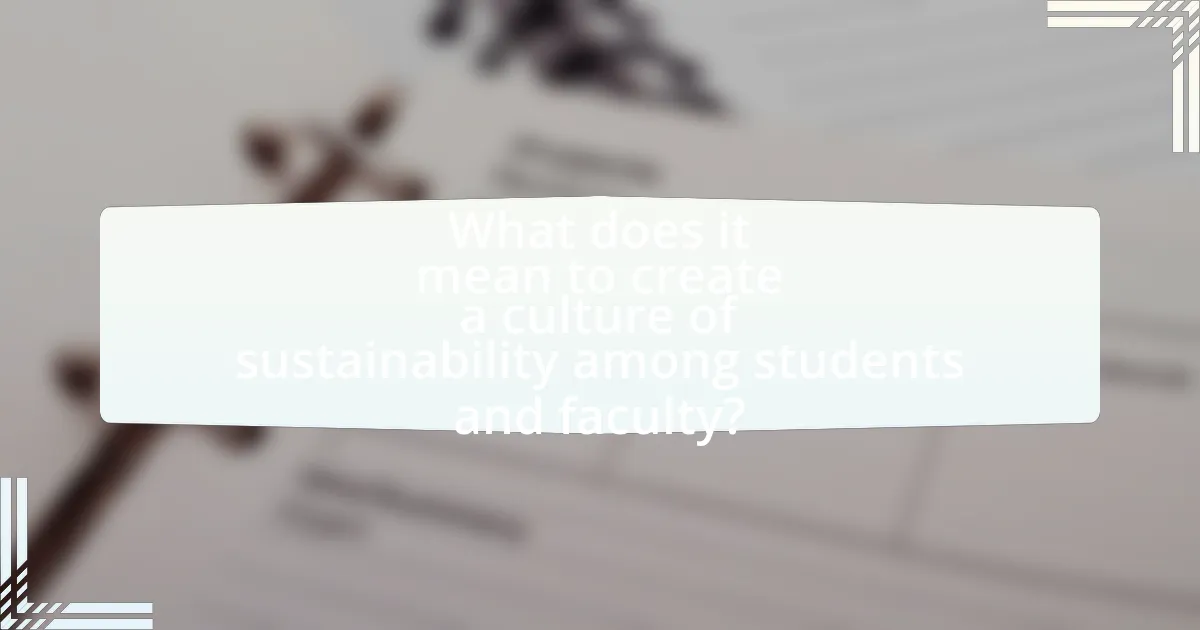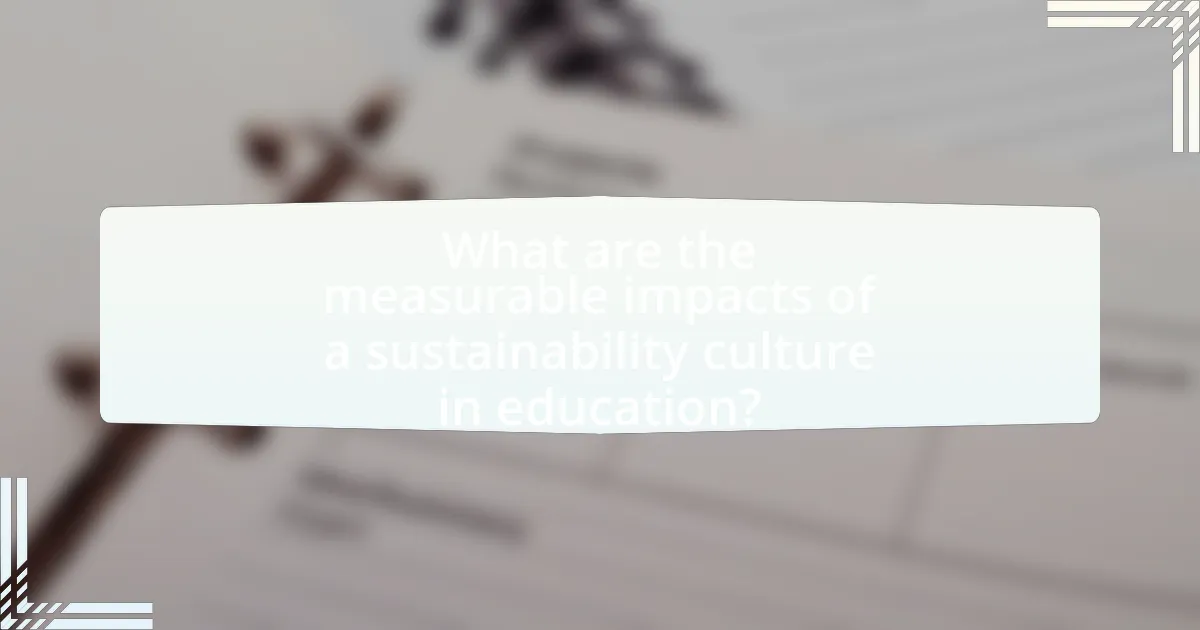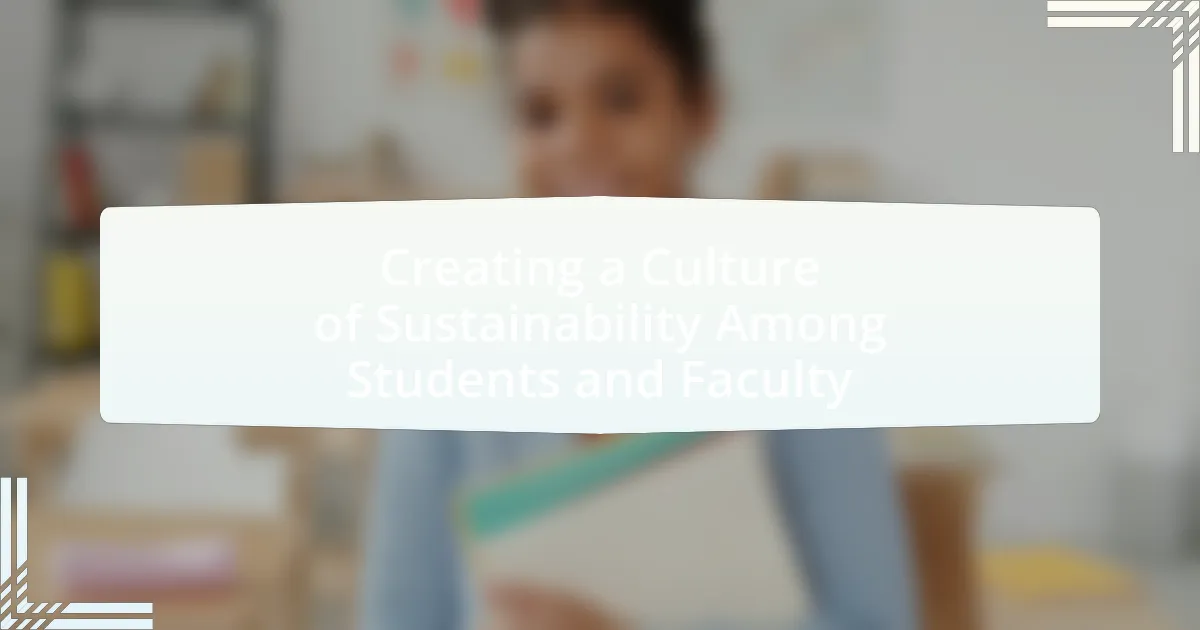Creating a culture of sustainability among students and faculty involves integrating sustainable practices into educational frameworks, decision-making, and daily activities. This article outlines the definition of sustainability in education, key principles such as environmental stewardship and social equity, and the importance of sustainability for academic communities. It also addresses challenges in fostering this culture, strategies for promoting sustainable behaviors, and the role of collaboration and partnerships in enhancing sustainability efforts. Additionally, the article discusses measurable impacts of sustainability initiatives and best practices for effective communication and resource utilization in educational settings.

What does it mean to create a culture of sustainability among students and faculty?
Creating a culture of sustainability among students and faculty means fostering an environment where sustainable practices are integrated into daily activities, decision-making, and educational frameworks. This involves promoting awareness of environmental issues, encouraging responsible resource use, and implementing initiatives that reduce waste and carbon footprints. Evidence of this can be seen in educational institutions that adopt sustainability curricula, engage in community service projects focused on environmental stewardship, and establish policies that prioritize eco-friendly practices, such as recycling programs and energy-efficient facilities. These actions collectively contribute to a shared commitment to sustainability, influencing behaviors and attitudes towards environmental responsibility within the academic community.
How can we define sustainability in an educational context?
Sustainability in an educational context refers to the integration of environmental, social, and economic considerations into the learning process and institutional practices. This definition encompasses the promotion of responsible resource use, the fostering of critical thinking about ecological impacts, and the encouragement of community engagement among students and faculty. Research indicates that educational institutions that adopt sustainability practices not only enhance student learning outcomes but also contribute to broader societal goals, such as reducing carbon footprints and promoting social equity. For instance, a study by the Association for the Advancement of Sustainability in Higher Education found that colleges implementing sustainability initiatives reported improved student engagement and academic performance.
What are the key principles of sustainability relevant to education?
The key principles of sustainability relevant to education include environmental stewardship, social equity, and economic viability. Environmental stewardship emphasizes the responsible use and protection of the natural environment through education that fosters awareness and action towards ecological conservation. Social equity focuses on ensuring that all individuals have access to educational resources and opportunities, promoting inclusivity and diversity within educational settings. Economic viability involves teaching students about sustainable practices that support long-term economic health while minimizing negative environmental impacts. These principles are essential for creating a culture of sustainability among students and faculty, as they encourage a holistic approach to education that integrates ecological, social, and economic dimensions.
Why is sustainability important for students and faculty?
Sustainability is important for students and faculty because it fosters a responsible and ethical approach to resource management and environmental stewardship. By integrating sustainability into their education and practices, students and faculty can contribute to reducing ecological footprints and promoting social equity. Research indicates that educational institutions that prioritize sustainability can enhance student engagement and academic performance, as seen in a study published in the Journal of Cleaner Production, which found that sustainability-focused curricula lead to improved critical thinking and problem-solving skills among students. Furthermore, faculty involvement in sustainability initiatives can enhance institutional reputation and attract funding, as institutions recognized for their commitment to sustainability often receive more grants and support.
What are the challenges in fostering a culture of sustainability?
The challenges in fostering a culture of sustainability include resistance to change, lack of awareness, and insufficient resources. Resistance to change often stems from established habits and skepticism about the effectiveness of sustainability initiatives. A study by the National Wildlife Federation found that 70% of students feel unprepared to address environmental issues, indicating a significant lack of awareness and education on sustainability topics. Additionally, insufficient resources, such as funding and time, hinder the implementation of sustainability programs, as highlighted by the Association for the Advancement of Sustainability in Higher Education, which reported that many institutions struggle to allocate necessary budgets for sustainability efforts.
What obstacles do students face in adopting sustainable practices?
Students face several obstacles in adopting sustainable practices, including lack of awareness, limited resources, and social pressures. Many students are not fully informed about the importance of sustainability or the specific actions they can take, which hinders their ability to engage in eco-friendly behaviors. Additionally, financial constraints often limit access to sustainable products or initiatives, making it difficult for students to implement these practices in their daily lives. Social pressures, such as peer influence and cultural norms, can also discourage students from prioritizing sustainability, as they may feel that such practices are not valued within their social circles. These factors collectively create significant barriers to the widespread adoption of sustainable practices among students.
How can faculty overcome resistance to sustainability initiatives?
Faculty can overcome resistance to sustainability initiatives by actively engaging students and colleagues through education and collaboration. By incorporating sustainability into the curriculum and demonstrating its relevance to students’ lives, faculty can foster a deeper understanding and appreciation for these initiatives. Research shows that when faculty members involve students in decision-making processes related to sustainability, it increases buy-in and reduces resistance. For instance, a study published in the Journal of Environmental Education found that participatory approaches in sustainability education significantly enhance student engagement and commitment to sustainability practices.

How can educational institutions promote sustainability among students and faculty?
Educational institutions can promote sustainability among students and faculty by integrating sustainability into the curriculum and campus operations. This approach encourages awareness and engagement with sustainable practices. For instance, universities that incorporate sustainability-focused courses and programs, such as environmental science or sustainable business, equip students with the knowledge to address environmental challenges. Additionally, implementing campus-wide initiatives like recycling programs, energy-efficient buildings, and sustainable transportation options demonstrates a commitment to sustainability, fostering a culture of responsibility. Research shows that institutions with strong sustainability programs report higher student engagement and satisfaction, indicating that such efforts resonate with the academic community.
What strategies can be implemented to encourage sustainable behaviors?
To encourage sustainable behaviors, educational institutions can implement strategies such as integrating sustainability into the curriculum, promoting campus-wide recycling programs, and organizing community engagement initiatives. Integrating sustainability into the curriculum ensures that students understand the importance of environmental stewardship, as studies show that education significantly influences pro-environmental behaviors. For example, a study published in the Journal of Environmental Education Research found that students exposed to sustainability concepts are more likely to adopt eco-friendly practices. Additionally, promoting campus-wide recycling programs increases participation in waste reduction efforts, as evidenced by a report from the National Recycling Coalition, which states that effective recycling initiatives can lead to a 30% increase in recycling rates. Lastly, organizing community engagement initiatives, such as tree planting or clean-up events, fosters a sense of responsibility and collective action among students and faculty, reinforcing sustainable practices within the community.
How can curriculum changes support sustainability education?
Curriculum changes can support sustainability education by integrating sustainability principles across various subjects and promoting interdisciplinary learning. This approach allows students to understand the interconnectedness of environmental, social, and economic issues, fostering critical thinking and problem-solving skills essential for addressing sustainability challenges. For instance, incorporating project-based learning that focuses on real-world sustainability issues can enhance student engagement and practical application of knowledge. Research indicates that schools implementing sustainability-focused curricula report increased student awareness and involvement in sustainability initiatives, demonstrating the effectiveness of such educational reforms in cultivating a culture of sustainability among students and faculty.
What role do extracurricular activities play in promoting sustainability?
Extracurricular activities play a crucial role in promoting sustainability by engaging students in hands-on projects that foster environmental awareness and responsible practices. These activities, such as gardening clubs, recycling initiatives, and environmental advocacy groups, provide practical experiences that enhance understanding of sustainability concepts. For instance, participation in a school garden not only teaches students about organic farming but also emphasizes the importance of local food systems and biodiversity. Research indicates that students involved in such activities are more likely to adopt sustainable behaviors in their daily lives, as evidenced by a study published in the Journal of Environmental Education, which found that students who participated in environmental clubs showed a 30% increase in sustainable practices compared to their peers. Thus, extracurricular activities serve as a vital platform for instilling a culture of sustainability among students and faculty.
How can collaboration enhance sustainability efforts in education?
Collaboration can enhance sustainability efforts in education by fostering shared resources, knowledge exchange, and collective problem-solving among students, faculty, and community stakeholders. When educational institutions partner with local organizations, they can implement joint initiatives that promote sustainable practices, such as recycling programs and energy conservation projects. For instance, a study by the National Wildlife Federation found that schools engaging in community partnerships reported a 20% increase in student participation in sustainability programs. This collaborative approach not only amplifies the impact of sustainability efforts but also cultivates a culture of environmental stewardship among all participants.
What partnerships can be formed to support sustainability initiatives?
Partnerships that can be formed to support sustainability initiatives include collaborations between educational institutions and local governments, non-profit organizations, and businesses focused on sustainable practices. Educational institutions can partner with local governments to implement community-based sustainability projects, such as recycling programs and energy efficiency initiatives, which have been shown to enhance community engagement and environmental awareness. Collaborations with non-profit organizations can provide access to resources, expertise, and funding for sustainability initiatives, as evidenced by programs like the Campus Sustainability Partnership, which connects universities with sustainability-focused NGOs. Additionally, partnerships with businesses that prioritize sustainability can lead to internships, research opportunities, and funding for student-led projects, fostering a culture of sustainability among students and faculty.
How can student organizations contribute to a culture of sustainability?
Student organizations can contribute to a culture of sustainability by implementing initiatives that promote environmental awareness and responsible practices among their members and the wider campus community. These organizations can host events such as clean-up drives, sustainability workshops, and educational campaigns that inform students about the importance of reducing waste and conserving resources. For instance, a study by the National Wildlife Federation found that campuses with active student-led sustainability groups reported higher levels of student engagement in eco-friendly practices, demonstrating the effectiveness of peer influence in fostering sustainable behaviors. Additionally, student organizations can collaborate with university administration to develop policies that support sustainability, such as advocating for the use of renewable energy sources on campus.

What are the measurable impacts of a sustainability culture in education?
A sustainability culture in education leads to measurable impacts such as increased student engagement, improved academic performance, and enhanced environmental awareness. Research indicates that schools implementing sustainability practices see a 20% increase in student participation in environmental programs, which correlates with higher academic achievement. Additionally, a study by the National Wildlife Federation found that schools with sustainability initiatives report a 30% improvement in student attendance, suggesting that a commitment to sustainability fosters a more positive learning environment. Furthermore, students exposed to sustainability education demonstrate a 50% increase in environmental literacy, as measured by standardized assessments. These statistics underscore the significant benefits of integrating sustainability into educational frameworks.
How can we assess the effectiveness of sustainability initiatives?
To assess the effectiveness of sustainability initiatives, organizations can utilize metrics such as carbon footprint reduction, resource conservation rates, and stakeholder engagement levels. These metrics provide quantifiable data that reflect the impact of sustainability efforts. For instance, a study by the Carbon Trust found that organizations implementing sustainability initiatives can reduce their carbon emissions by up to 30% within five years. Additionally, surveys measuring community awareness and participation can indicate the cultural shift towards sustainability among students and faculty. This combination of quantitative and qualitative assessments ensures a comprehensive evaluation of sustainability initiatives.
What metrics can be used to evaluate student engagement in sustainability?
Metrics that can be used to evaluate student engagement in sustainability include participation rates in sustainability-related events, student feedback surveys on sustainability initiatives, and the number of sustainability-focused projects or courses undertaken by students. Participation rates provide quantitative data on how many students are involved in sustainability activities, indicating their interest and commitment. Student feedback surveys can reveal qualitative insights into students’ perceptions and attitudes towards sustainability efforts, helping to assess engagement levels. Additionally, tracking the number of sustainability-focused projects or courses allows institutions to measure the integration of sustainability into the academic curriculum, reflecting student engagement in learning about sustainability issues.
How can faculty contributions to sustainability be measured?
Faculty contributions to sustainability can be measured through various metrics, including research output, curriculum integration, community engagement, and participation in sustainability initiatives. Research output can be quantified by the number of publications and projects focused on sustainability topics, demonstrating faculty expertise and commitment. Curriculum integration can be assessed by evaluating the inclusion of sustainability concepts in courses and programs, which reflects the faculty’s role in educating students about sustainable practices. Community engagement can be measured by faculty involvement in local sustainability projects, partnerships, and outreach activities, showcasing their impact beyond the classroom. Participation in sustainability initiatives, such as campus sustainability committees or events, can also serve as a metric, indicating faculty leadership and advocacy for sustainable practices within the institution. These metrics provide a comprehensive framework for evaluating faculty contributions to sustainability efforts.
What best practices can be adopted for creating a sustainable culture?
To create a sustainable culture, institutions should implement practices such as integrating sustainability into the curriculum, promoting community engagement, and fostering a culture of continuous improvement. Integrating sustainability into the curriculum ensures that students and faculty understand the importance of environmental stewardship, as evidenced by studies showing that educational programs focused on sustainability lead to increased awareness and behavioral changes among participants. Promoting community engagement through partnerships with local organizations can enhance practical learning experiences and encourage collaborative efforts towards sustainability goals. Additionally, fostering a culture of continuous improvement involves regularly assessing sustainability initiatives and encouraging feedback, which has been shown to enhance commitment and innovation in sustainability practices within educational settings.
How can institutions effectively communicate sustainability goals?
Institutions can effectively communicate sustainability goals by utilizing clear messaging, engaging stakeholders, and leveraging multiple communication channels. Clear messaging ensures that sustainability goals are articulated in a straightforward manner, making them easily understandable for students and faculty. Engaging stakeholders, such as students, faculty, and community members, fosters a sense of ownership and accountability towards these goals. Utilizing various communication channels, including social media, newsletters, and campus events, enhances visibility and encourages participation. Research indicates that institutions that actively involve their communities in sustainability initiatives see higher levels of engagement and commitment, as evidenced by a study published in the Journal of Cleaner Production, which found that participatory approaches significantly improve sustainability outcomes in educational settings.
What resources are available to support sustainability initiatives in education?
Resources available to support sustainability initiatives in education include grants, educational programs, and partnerships with environmental organizations. For instance, the U.S. Environmental Protection Agency offers various grants aimed at promoting sustainability in schools, such as the Environmental Education Grants Program, which provides funding for projects that enhance environmental literacy. Additionally, organizations like the National Wildlife Federation and the Green Schools Alliance provide resources, toolkits, and networking opportunities for educators to implement sustainability practices. These resources are designed to foster a culture of sustainability among students and faculty by providing practical support and funding for innovative projects.

Leave a Reply